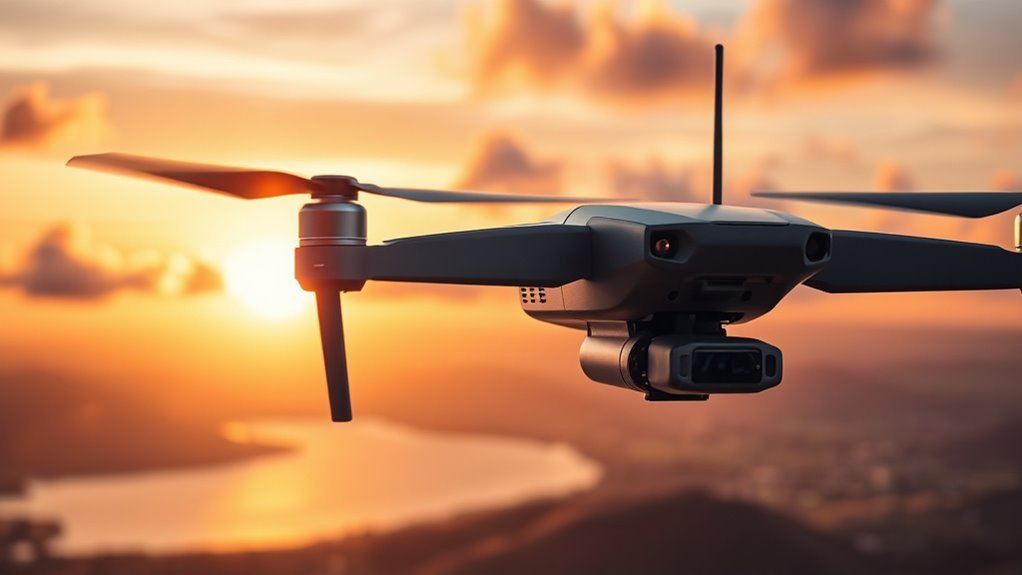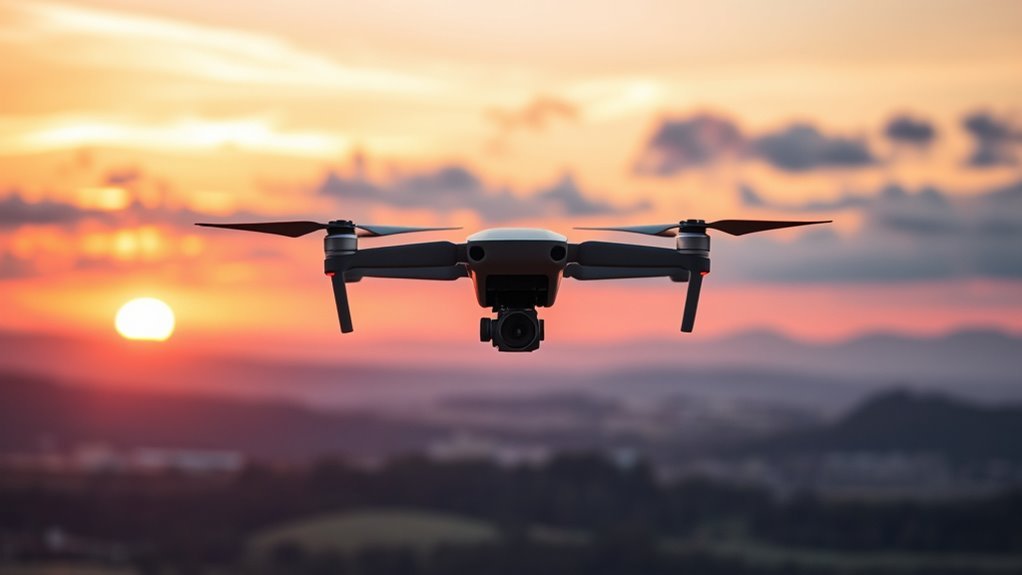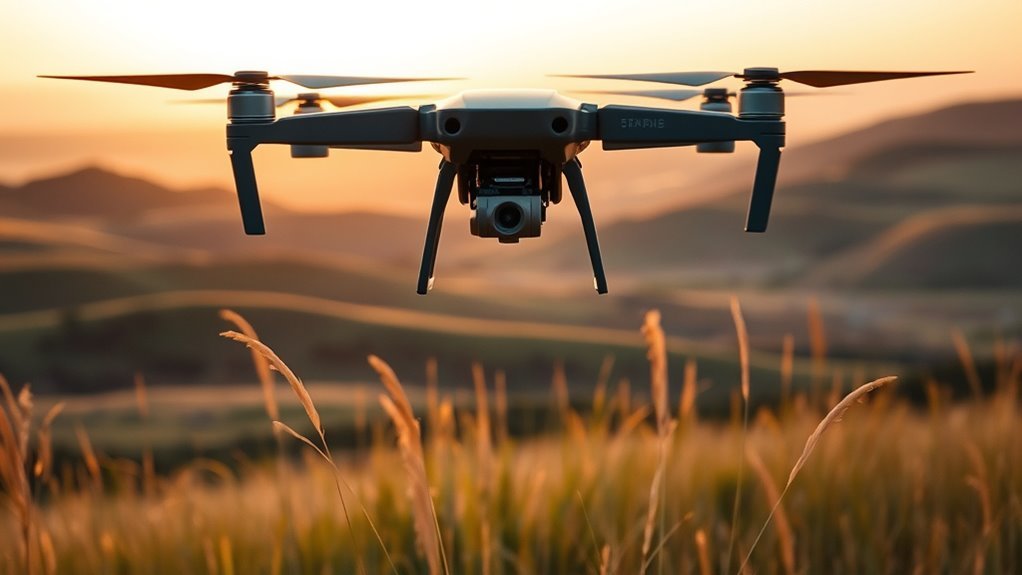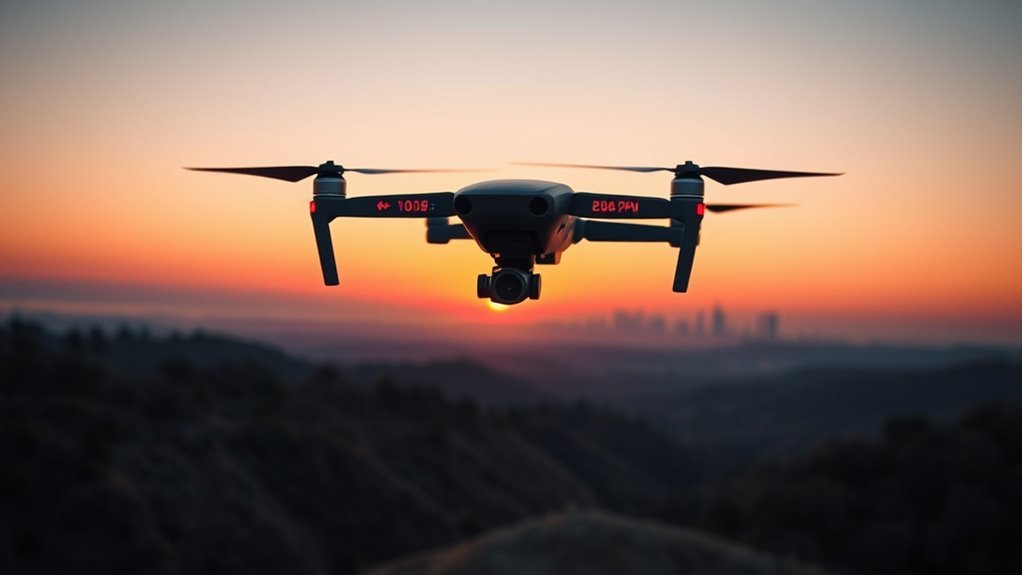The distance a drone can travel depends on several key factors. Battery life and capacity greatly impact flight duration, while weight and payload affect drone efficiency. The design and aerodynamics of the drone also play essential roles. Environmental conditions, such as wind and temperature, can alter performance, and your piloting skills influence energy management. Additionally, regulatory restrictions might limit where you can fly. Understanding these elements will help you optimize your drone’s range. More insights await you.
Battery Life and Capacity

When evaluating drone range, one of the most critical factors is battery life and capacity. The type of battery chemistry directly impacts energy density, which is the amount of energy stored per unit weight. Higher energy density translates to longer flight times, allowing you to explore more extensive areas without the need for frequent recharges. Lithium polymer (LiPo) batteries, for instance, offer superior energy density compared to traditional nickel-cadmium options, enabling drones to achieve peak performance. Additionally, understanding the capacity measured in milliamp-hours (mAh) helps in estimating how long your drone can operate under specific conditions. By choosing batteries with advanced chemistry and peak energy density, you can maximize your drone’s range and enjoy the freedom of extended aerial exploration. Effective power management is also essential for optimizing energy consumption during flights. Furthermore, the selection of ideal battery chemistry and energy density is crucial for sustained power output throughout your drone’s operational duration.
Weight and Payload

Battery life and capacity play a significant role in determining how far a drone can travel, but weight and payload also heavily influence flight performance. The payload capacity of your drone dictates how much weight it can safely carry without compromising flight efficiency. When you exceed this limit, you risk shortening flight time and affecting maneuverability. Proper weight distribution is essential; uneven loading can lead to instability and increased drag, further reducing range. If you’re looking to maximize your drone’s distance, consider minimizing excess weight and ensuring that any payload is evenly distributed. Additionally, efficient power management can optimize energy use, allowing for longer flights even with heavier payloads. By carefully balancing these factors, you can enhance your drone’s performance, giving you the freedom to explore more expansive areas without the worry of limitation. Moreover, understanding the payload capacity of your drone helps in selecting appropriate equipment that maintains optimal flight performance.
Drone Design and Aerodynamics

When considering drone design and aerodynamics, you’ll need to evaluate the interplay between weight, materials, and propeller efficiency. Each component greatly impacts battery capacity and overall flight range. Understanding these factors is vital for optimizing performance and extending your drone’s operational limits. For instance, battery life comparison highlights how different battery technologies can significantly influence a drone’s endurance and mission capabilities. Additionally, the type of transmission technologies used can also affect the effective operational range of a drone, impacting how far it can be deployed during missions.
Weight and Materials
The weight and materials used in drone design play a significant role in determining flight range and efficiency. A well-balanced drone optimizes performance by considering material strength and weight distribution. When you choose materials wisely, you enhance both durability and flight duration.
- Lightweight composites can reduce overall weight, improving efficiency.
- Metal components provide strength but may increase weight, affecting range.
- Weight distribution impacts stability and maneuverability, essential for long flights.
- Battery weight and capacity directly influence how far you can go.
Understanding these factors allows you to make informed design choices, ensuring you achieve the freedom to explore vast distances while maintaining control and safety in your drone’s flight.
Propeller Efficiency
Many factors influence drone performance, and propeller efficiency is among the most critical. The design of your propellers plays a crucial role in thrust generation, impacting how far your drone can travel. Efficient propeller design minimizes drag while maximizing lift, ensuring that energy is utilized effectively. A well-designed propeller can greatly enhance flight duration and range by optimizing airflow and reducing turbulence. You’ll want to take into account factors like blade shape, pitch, and size, as these elements directly affect performance. By focusing on propeller efficiency, you can improve your drone’s overall capabilities, allowing it to cover greater distances while conserving energy. This balance is essential for achieving the freedom to explore vast areas without the constant worry of power limitations.
Battery Capacity
While propeller efficiency plays an essential role in drone range, battery capacity considerably influences how far a drone can fly. The integration of advanced battery technology directly impacts energy efficiency, determining the overall endurance of your drone. Here are some factors to take into account regarding battery capacity:
- Battery Type: Lithium-polymer (LiPo) batteries often provide a balance of weight and power.
- Cell Count: More cells can increase voltage, enhancing performance.
- Weight: Heavier batteries can reduce flight time, affecting range.
- Discharge Rate: High discharge rates can lead to quicker energy depletion.
Incorporating the right battery choices is vital for maximizing flight duration and ensuring you get the most out of your drone’s capabilities.
Transmission Range
Transmission range is a critical factor in determining a drone’s operational capabilities, as it directly influences how far you can fly your device from its controller. This range is primarily dictated by the frequency bands used for communication. Drones typically operate on 2.4 GHz or 5.8 GHz bands, each with its own advantages and drawbacks. The lower 2.4 GHz band offers longer range but is more susceptible to signal interference from other devices. Conversely, the 5.8 GHz band provides a clearer signal with reduced interference, but its range may be limited. Understanding these dynamics allows you to optimize your drone’s transmission range, enhancing your flying experience and freedom while mitigating potential disruptions in communication. Moreover, the choice of frequency impacts signal quality and interference, making it essential to consider the environment in which you fly your drone. Additionally, optimizing propeller size and pitch can improve overall efficiency, further extending your drone’s operational range.
Environmental Conditions
When evaluating the operational range of a drone, environmental conditions play a pivotal role that can greatly impact flight performance. The way weather and terrain interact with your drone’s capabilities can either enhance or limit your flying experience. Here are some key factors to evaluate:
- Weather impact: Wind speed and direction can affect stability and battery consumption. Additionally, battery capacity directly influences how far your drone can travel before needing to return.
- Temperature: Extreme heat or cold can degrade battery life and performance.
- Terrain influence: Hilly or mountainous areas can obstruct signals and limit range.
- Obstacles: Trees, buildings, and other structures can interfere with line-of-sight transmission. Additionally, weather conditions such as humidity can influence air density and sensor performance, further affecting operational capacity.
Pilot Skill and Experience
Your understanding of regulations and flight techniques greatly impacts drone range. A proficient pilot can optimize flight paths and manage battery consumption effectively, while knowledge of legal limits guarantees compliance and safety. Together, these factors shape not only how far you can fly but how efficiently you can operate your drone.
Knowledge of Regulations
Although understanding regulations may seem secondary to technical specifications, a pilot’s skill and experience in adhering to these rules considerably influence drone range. Regulatory compliance is crucial not just for safety but also for maximizing the drone’s operational capabilities. Your awareness of legal considerations can prevent costly penalties and interruptions in your flight plans.
- Knowledge of local airspace restrictions
- Familiarity with no-fly zones and temporary flight restrictions
- Understanding of pilot certification requirements
- Ability to interpret and apply updated regulations
These factors guarantee that you can navigate your drone freely while staying within the bounds of the law. Ultimately, a well-informed pilot can extend their drone’s range by skillfully managing compliance with regulations.
Flight Technique Proficiency
Flight technique proficiency considerably impacts a drone’s operational range, as pilot skill and experience directly influence the efficiency of flight maneuvers. Mastery of various flight maneuvers techniques enables you to navigate obstacles and optimize battery usage, ultimately extending your drone’s reach. Advanced piloting strategies, such as understanding wind patterns and energy management, can drastically improve your flight performance. For example, skilled pilots can adjust altitude and velocity during flight to conserve power while maintaining stability. Additionally, proficiency in emergency procedures allows you to respond effectively to unexpected situations, minimizing loss. Consequently, investing time in developing your piloting skills can lead to greater freedom in exploration and more successful missions, enhancing your overall drone experience.
Regulatory Restrictions
While many factors influence drone range, regulatory restrictions can greatly limit operational capabilities. Understanding these limitations is essential for maximizing your drone’s potential.
Consider the following regulatory aspects:
- Airspace restrictions: Different altitudes and zones may be off-limits for drone operations.
- Flight altitude limits: Regulations often cap how high your drone can fly, impacting its range.
- No-fly zones: Certain areas, like near airports or military installations, are prohibited for drone use.
- Regulatory compliance: Adhering to local laws can dictate where and how far you can legally operate your drone.
Maintenance and Upkeep
Proper maintenance and upkeep are essential to maximizing your drone’s range and performance. Regular drone maintenance directly influences battery efficiency, flight stability, and overall longevity. Implementing effective upkeep practices, such as routine inspections of motors, propellers, and electronic components, can prevent unexpected failures during flight. Additionally, keeping firmware updated guarantees your drone operates using the latest enhancements and fixes. Pay attention to battery care—charging cycles and storage conditions can greatly affect capacity and lifespan. Regular inspections help identify parts needing attention and, by adhering to these maintenance protocols, you not only extend your drone’s operational range but also assure a more reliable and enjoyable flying experience. Remember, a well-maintained drone is your key to achieving greater freedom in aerial exploration. Furthermore, understanding the battery life specifications of your drone can help you better manage its performance in various operational scenarios.
Frequently Asked Questions
How Do Different Drone Models Affect Flight Distance?
Different drone models influence flight distance based on their specifications, such as battery capacity and weight. Additionally, flight modes can optimize performance, allowing you to maximize range based on your specific needs and environment.
Can Altitude Influence a Drone’s Range?
Yes, altitude can influence a drone’s range. As you ascend, air density decreases, which affects lift and battery efficiency. Consequently, understanding altitude effects is essential for optimizing your drone’s performance and maximizing its flight distance.
What Role Does Battery Temperature Play in Performance?
Battery temperature’s impact on performance can be staggering; ideal thermal management guarantees battery efficiency. If temperatures soar or plummet, your drone’s range could plummet too, drastically limiting your aerial adventures. Keep it cool for freedom!
How Does Firmware Impact a Drone’s Distance Capabilities?
Firmware updates optimize your drone’s performance by enhancing communication protocols, reducing signal interference. This guarantees better distance capabilities, allowing you to maximize your drone’s range and enjoy the freedom of flying farther without compromising stability.
Are There Accessories That Can Extend a Drone’s Range?
Yes, accessories like range extenders and antenna upgrades can greatly enhance your drone’s operational range. By improving signal strength and connectivity, these modifications allow you to explore farther and capture more expansive aerial footage.

